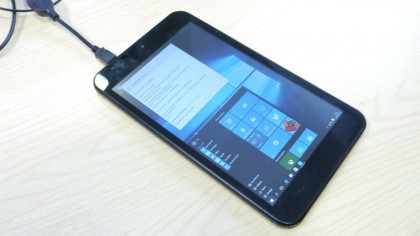Installing Windows 10 on a super cheap tablet: Learn from my mistakes
A few steps that turned into an ordeal
Windows 10 is pretty lean and easy to install but you still need a keyboard and a mouse. As I discovered in my previous experiments, the OS installation process doesn't coerce you into plugging your device into a power socket.
You can't run Windows 10 from Windows 8.1 on the Linx 7 tablet – trying to do so will bring up an error message saying that Windows 10 will not install on a compressed operating system (the Linx tablet uses a slightly different version of Windows 8.1, one that comes with WIMBoot).
The only other option is to perform a clean installation, and that's exactly what I did. To achieve this, first of all I charged the tablet, then I used an adaptor (micro-USB to USB), a 4-in-1 USB hub, a Bluetooth keyboard and a USB memory stick with the latest Windows 10 ISO and the necessary drivers.
You will have to access the BIOS and modify the boot sequence, then reboot. Follow the instructions (this is a standard Windows 10 setup, so should be fairly easy to execute) until you boot to the desktop (remember to remove the USB Boot drive or the setup process will start again).
Note that you won't be able to use the touchscreen during installation and the whole process will take place in portrait mode. The first thing you want to do is get Wi-Fi running; look for a Generic SDIO device in the device manager.
No sign of touch

From there, I couldn't get the touchscreen to work and that was it – no matter how hard I tried, I couldn't get the right driver. I don't blame Windows 10 but it shows that on more exotic hardware, Microsoft's latest operating system might have a very hard time getting it right.
As for the Linx 7, I am currently forced to use it with a keyboard and a mouse, and the performance is far from being silky smooth even without any applications running. That's what you get running on 1GB of RAM and 32GB of onboard storage.
Are you a pro? Subscribe to our newsletter
Sign up to the TechRadar Pro newsletter to get all the top news, opinion, features and guidance your business needs to succeed!
But you can expect Microsoft to tweak Windows 10 further and deliver a slimline, compressed version like it did for Windows 8.1 for tablets, which will hopefully improve overall performance.
After initially installing Windows 10 10122, I updated to the final version of Windows 10 from inside the Insider preview itself using a standard bootable USB key. Wi-Fi is on by default but no sign of trouch capabilities.

Désiré has been musing and writing about technology during a career spanning four decades. He dabbled in website builders and web hosting when DHTML and frames were in vogue and started narrating about the impact of technology on society just before the start of the Y2K hysteria at the turn of the last millennium.